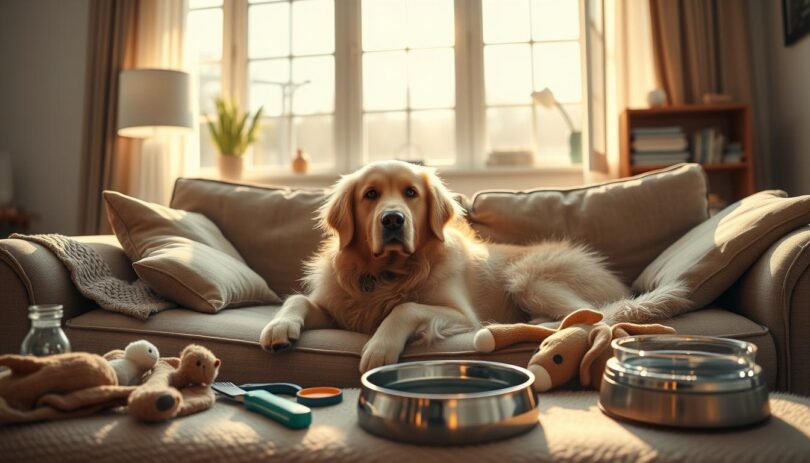Did you know that over 50% of dogs in America are obese? This surprising statistic highlights the importance of proper care for our pets. Whether you're a new dog owner or have years of experience, there's always more to learn about keeping your furry friend happy and healthy.
This comprehensive guide is designed to share expert tips on dog care, covering essential areas like health, training, exercise, and seasonal care. Based on insights from animal hospitals and trusted pet sources, we'll explore topics such as routine vet appointments, dental hygiene, puppy-proofing your home, exercise strategies, balanced nutrition, and emergency preparedness.
Our goal is to provide clear, actionable advice in a friendly and professional tone. By following this guide, you'll gain the knowledge to ensure your dog leads a fulfilling life. Let's dive in and explore how to make your dog's life the best it can be!
Understanding Dog Health and Wellness
Regular veterinary care is the cornerstone of maintaining your dog's overall health. Annual vet visits play a crucial role in detecting potential health issues early, which can significantly improve treatment outcomes. These check-ups also help maintain a detailed health record for your dog, ensuring that any changes are caught and addressed promptly.
Annual Vet Appointments and Health Check-Ups
Visiting a veterinarian annually allows for a thorough physical examination, which can uncover issues like obesity or joint problems before they become severe. These appointments also provide an opportunity to discuss any changes in your dog's behavior or health with a professional. Early detection of diseases can save both time and money, while also improving your dog's quality of life.
Dental Care and Oral Hygiene
Dental health is often overlooked but is vital for your dog's overall well-being. Brushing your dog's teeth regularly with a dog-specific toothpaste can prevent costly dental treatments down the line. Proper oral hygiene helps prevent systemic diseases that can arise from poor dental health. Use a toothbrush and toothpaste designed for dogs, as human products can be harmful. Regular dental care can also help maintain the softness of your dog's mouth and prevent bad breath.
By incorporating these practices into your routine, you can help ensure your dog leads a healthy and happy life. Always consult with your veterinarian to determine the best approach for your dog's specific needs.
Essential Dog Care and Housekeeping Tips
Creating a safe and comfortable home environment is crucial for your dog's well-being. By taking a few simple steps, you can protect your furry friend from household hazards and ensure a happy, healthy life together.
Puppy-Proof Your Home
Puppy-proofing your home is an essential part of dog care. Start by securing trash bins and dangerous products. Use baby-proof locks on cabinets to keep cleaning supplies out of reach. This helps prevent accidental ingestion and keeps your home safe for your dog.
Managing Household Toxins and Trash
Regularly clean your dog’s bedding and toys to minimize exposure to allergens and fleas. Choose pet-friendly household products to maintain a hazard-free environment for the entire family. A designated safe space can help your dog feel secure during stressful times, like parties or thunderstorms.
Comprehensive Exercise and Mental Stimulation Strategies
Exercise and mental stimulation are vital for your dog's overall well-being. A balanced routine can help prevent boredom and behavioral issues while strengthening your bond with your furry friend.
Daily Walks and Outdoor Activities
Daily walks are more than just exercise; they provide mental stimulation. Exploring new routes exposes your dog to fresh sights and smells, keeping them engaged. Even a 15-minute walk can make a big difference in their mood and energy levels.
Mental Puzzles and Interactive Games
Mental puzzles and interactive games are great ways to challenge your dog. Puzzle toys filled with treats encourage problem-solving, reducing destructive behavior. Scatter feeding and snuffle mats also engage their sense of smell, keeping them occupied and mentally stimulated.
Exercising Together for a Stronger Bond
Spending time with your dog through exercise strengthens your relationship. Whether it's a walk or playtime, these moments create lasting memories and a deeper connection. Tailor activities to your dog's age and health for the best results.
By combining physical and mental activities, you can ensure your dog leads a happy and healthy life. Every moment spent together is an opportunity to nurture their well-being and your bond.
Strengthening Your Bond Through Quality Time
Quality time with your pup is more than just fun—it's essential for building trust and encouraging positive behavior. By dedicating intentional moments to interact with your dog, you foster a deeper connection that benefits both of you.
Intentional Play and Positive Touch
Engaging in intentional play helps reinforce desirable actions and reduces fear-based behaviors. Simple activities like gentle petting, handling paws and ears, or playful interactions create a sense of security and trust. These moments not only strengthen your bond but also make grooming tasks easier for your pup.
Consistency is key. Set aside time each day for these interactions, ensuring each session is nurturing and engaging. This routine helps your pup feel secure and relaxed, knowing they can depend on your positive presence in their life.
By prioritizing quality time, you create a foundation of trust and mutual respect. This connection not only enhances your pup's behavior but also enriches your shared experiences, making every moment together truly special.
All the Tips of Dogs for Successful Training
Training your dog is about more than just teaching commands—it's about building a strong bond and establishing clear communication. A well-trained dog is not only better behaved but also more confident and emotionally balanced. Positive reinforcement and consistent commands are key to successful training.
Positive Reinforcement and Reward Systems
Positive reinforcement is a powerful training method that focuses on rewarding desired behaviors. Use treats, praise, and affection to encourage good actions. For example, when your dog sits on command, reward them with a small, tasty treat. This creates a positive association with the action, making them more likely to repeat it.
A valuable tip is to use high-value rewards for difficult tasks. Small, soft treats work best because they can be consumed quickly, keeping the training session flowing. Avoid large treats that distract your dog or cause unwanted behavior.
Consistent Commands and Immediate Feedback
Consistency is crucial in training. Use the same commands and hand signals every time to avoid confusing your dog. For instance, use “sit” instead of “sit down” to keep things clear. Immediate feedback is also essential—reward or correct behavior within seconds of the action.
Adjust your training approach based on your dog's progress and personality. Some dogs respond better to food rewards, while others prefer praise. Be patient and adapt your methods to what works best for your furry friend.
By combining positive reinforcement with consistent commands, you'll see significant improvements in your dog's behavior. Remember, every training session is an opportunity to strengthen your bond and help your dog become a well-behaved, loyal companion.
Seasonal Care: Winter and Summer Essentials
Adapting your dog's care routine to seasonal changes is essential for their health and comfort. Whether it's the icy chill of winter or the sweltering heat of summer, understanding how to protect your dog ensures they stay safe and happy year-round.
Winter: Moisturizing Paws and Limited Outdoor Time
Cold winter air can dry out your dog's paws, making them prone to cracking. Use a pet-safe moisturizer to keep their paws soft and protected. Limit outdoor time during extreme cold snaps to prevent frostbite, especially on sensitive areas like ears and paws. Consider using a dog coat or sweater for shorter-haired breeds to keep them warm.
After winter walks, clean your dog's paws thoroughly to remove any ice melt or salt. This helps prevent irritation and keeps their paws healthy.
Summer: Hydration, Shade, and Heat Protection
Summer heat requires extra attention to your dog's hydration. Ensure they always have access to fresh water, and provide shade when spending time outdoors. Never leave your dog in a hot car, as temperatures can rise dangerously within minutes, risking heatstroke.
Monitor your dog's behavior for signs of heat stress, such as panting or lethargy. Use cooling accessories like bandanas or mats to help them stay comfortable. Protect their paws from hot pavement by walking them in the early morning or evening when surfaces are cooler.
Strategies for Promoting Long-Term Dog Health
Maintaining your dog's long-term health requires a combination of proper nutrition, consistent weight management, and regular preventative care. These strategies help prevent chronic health issues and ensure your dog enjoys a high quality of life.
Nutrition, Weight Management, and Diet Tips
A balanced diet is essential for your dog's overall health. Feeding high-quality dog food with controlled portion sizes can prevent obesity and related health issues. Monitoring your dog's weight through Body Condition Scoring helps identify if they're at a healthy weight, ensuring their diet meets their nutritional needs.
As your dog ages, their dietary requirements change. Puppies, adults, and seniors each need different levels of nutrients. For example, senior dogs may require fewer calories but more protein to maintain muscle mass. Incorporating omega-3 fatty acids can support joint health and cognitive function.
Routine Vaccinations and Preventative Care
Routine vaccinations are crucial for protecting your dog from dangerous diseases. Core vaccines, such as rabies and distemper, are essential for all dogs, while others may be needed based on lifestyle. Regular check-ups allow your vet to catch potential health issues early, improving outcomes and preventing severe problems.
Quick Solutions for Emerging Health Issues
When your dog faces a sudden health issue, quick action is essential. Whether it's an injury or an unexpected problem, knowing how to respond can make a big difference.
Administering Medication Safely
Giving medication to your dog requires care. For liquid medication, use a dropper to ensure the correct dose. If your dog refuses pills, hide them in a treat to make it easier. Always follow your vet's instructions to avoid overdose or side effects.
Emergency Plans and Assembling a Pet First Aid Kit
A prepared first aid kit is vital for emergencies. Include bandages, antiseptic wipes, and a muzzle. Know the nearest emergency vet clinic and keep their contact info handy. In case of severe issues like vomiting or difficulty breathing, seek immediate help.
For any urgent questions, consult your veterinarian. Keep emergency supplies accessible to ensure your dog's safety and well-being.
Wrapping Up Your Journey to Being a Top Pet Parent
As you conclude your journey through this guide, remember that caring for your dog is a lifelong commitment. By focusing on proactive care, you can ensure your furry friend enjoys a happy, healthy life.
Regular vet visits, a balanced diet, and consistent training are just a few of the many strategies covered. These practices not only improve your dog's well-being but also strengthen your bond with them.
Don’t forget the importance of mental and physical stimulation. Activities like daily walks and interactive games keep your dog engaged and prevent boredom. Seasonal adjustments, such as protecting paws in winter and providing shade in summer, are also crucial for their comfort.
Stay proactive with preventative measures like vaccinations and parasite control. Being prepared for emergencies and maintaining open communication with your vet ensures you’re always ready to address any health issues.
By following these guidelines, you’re well-equipped to give your dog the care they deserve. Every effort you make contributes to their happiness and longevity, making your shared life together truly special.





Leave a Comment